Be a Mastermind: A CBT activity to promote calm thinking, cognitive flexibility and mastery of emotions.
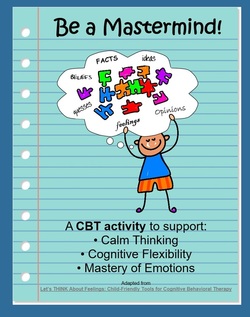
Be a Mastermind: A CBT activity to promote calm thinking
Rationale:
An important component of CBT is learning
1) to distinguish between facts and perceptions (beliefs, opinions, guesses, etc.)
2) to then evaluate those beliefs, opinions and guesses: which are helpful and which are not so helpful?
This activity sets the groundwork for developing cognitive flexibility: the ability to "master your mind" and choose the best, most helpful ways of thinking.
Application:: This resource is intended for psychotherapists who already practice cognitive behavioral therapy with children. Its purpose is to provide visual tools to make the concepts of CBT more accessible for children. It contains an in-session activity as well as a take-home component.
Goals: With this activity, the child:
* identifies a stressful or challenging situation
* identifies the emotions experienced
* describes the facts of what happened
* identifies subsequent thoughts/perceptions (opinions, beliefs, guesses, etc.)
* evaluates the thoughts: are they helpful or not?
View and print Be a Mastermind: A CBT activity
An important component of CBT is learning
1) to distinguish between facts and perceptions (beliefs, opinions, guesses, etc.)
2) to then evaluate those beliefs, opinions and guesses: which are helpful and which are not so helpful?
This activity sets the groundwork for developing cognitive flexibility: the ability to "master your mind" and choose the best, most helpful ways of thinking.
Application:: This resource is intended for psychotherapists who already practice cognitive behavioral therapy with children. Its purpose is to provide visual tools to make the concepts of CBT more accessible for children. It contains an in-session activity as well as a take-home component.
Goals: With this activity, the child:
* identifies a stressful or challenging situation
* identifies the emotions experienced
* describes the facts of what happened
* identifies subsequent thoughts/perceptions (opinions, beliefs, guesses, etc.)
* evaluates the thoughts: are they helpful or not?
View and print Be a Mastermind: A CBT activity
SCHOOL DAYS - UPS & DOWNS
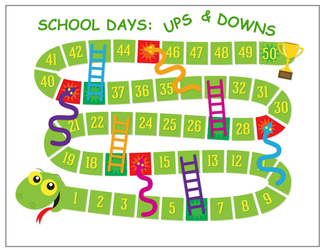
Click on image to view and print board
Target population: Elementary to middle school students.
Rationale: School can be a source of stress for many children. They may not be able to easily articulate the perceptions and beliefs that give rise to feelings of anxiety, anger, and/or discouragement about school-related situations. This activity provides an engaging, non-threatening format for the therapist or counselor to begin to explore the child’s perceptions and beliefs. It can also be used to introduce the concept of cognitive re-framing: that the way one thinks about a situation can influence one’s subsequent emotions and behavior.
Goal:
1) explore experiences, perceptions, beliefs, and feelings regarding school-related issues
2) teach basic cognitive re-framing skills
Pre-requisite knowledge for counselor/therapist:
Some knowledge of cognitive-behavioral therapy for the Think It Over cards.
View and print instructions and cards
View and print game board
FALL 2014: Stressometer
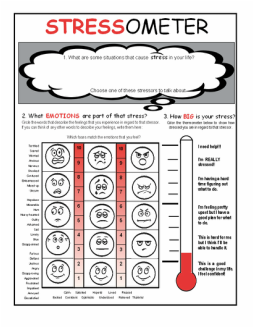
RATIONALE: Stress is a natural part of life and some stress can actually be healthy and good for us. However, therapy clients often have too many stressors and/or too few effective strategies for coping with stress, resulting in unhealthy stress. It is helpful for clients to be able to accurately identify not only the sources of stress (the stressors) in their lives but also to be able to measure their personal stress level, assessing where they fall on the healthy-unhealthy stress continuum.
Goal: The Stressometer activity provides a visual tool that therapists can use to help clients assess the impact of stress on their lives. This lays a foundation for planning therapeutic interventions that will eliminate or transform some of the stressors in the client’s life and/
or support the development of healthy methods of coping with stress.
Recommended Age Range: Ages 7 or 8 to adult
Treatment Modality: This activity is intended to be an assessment tool for individual therapy. It can also be adapted for conjoint or family therapy.
Click here to view and print instructions
Goal: The Stressometer activity provides a visual tool that therapists can use to help clients assess the impact of stress on their lives. This lays a foundation for planning therapeutic interventions that will eliminate or transform some of the stressors in the client’s life and/
or support the development of healthy methods of coping with stress.
Recommended Age Range: Ages 7 or 8 to adult
Treatment Modality: This activity is intended to be an assessment tool for individual therapy. It can also be adapted for conjoint or family therapy.
Click here to view and print instructions
SUMMER 2014: Family Treasure Quest
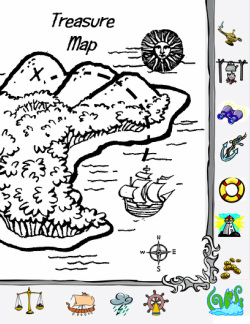
RATIONALE: Strength-based interventions can be used during the therapy process to help families recognize and build on their existing--and valuable--competencies and accomplishments.
Families often come into therapy with difficult and even traumatic stories to tell, and may feel overwhelmed by the events that they describe. Strength-based interventions help families to augment these difficult stories with positive narratives, drawing on their past experiences to highlight individual and family values, traits and characteristics. These enhanced stories can lay the groundwork for positive expectations for the therapeutic process. At the same time, they facilitate a shift in the family’s expectations of the therapeutic process: from the therapist having preconceived answers to the therapist helping the family search for unique
answers based on their characteristics and strengths.
APPLICATION: This activity is especially designed for use with families, but can be adapted for use in individual therapy.
GOAL: This playful intervention uses theme of a “treasure quest” to engage children and families in recognizing individual and family strengths. The activity provides a structure by which the therapist can initiate a dialog with the family that helps them to “search” for their strengths and to “dig beneath the surface” of family life to find the hidden treasure of shared values and competencies.
Note: Previous training in narrative therapy (or similar approaches) will help the therapist guide the dialog.
Click here to view and print instructions
Families often come into therapy with difficult and even traumatic stories to tell, and may feel overwhelmed by the events that they describe. Strength-based interventions help families to augment these difficult stories with positive narratives, drawing on their past experiences to highlight individual and family values, traits and characteristics. These enhanced stories can lay the groundwork for positive expectations for the therapeutic process. At the same time, they facilitate a shift in the family’s expectations of the therapeutic process: from the therapist having preconceived answers to the therapist helping the family search for unique
answers based on their characteristics and strengths.
APPLICATION: This activity is especially designed for use with families, but can be adapted for use in individual therapy.
GOAL: This playful intervention uses theme of a “treasure quest” to engage children and families in recognizing individual and family strengths. The activity provides a structure by which the therapist can initiate a dialog with the family that helps them to “search” for their strengths and to “dig beneath the surface” of family life to find the hidden treasure of shared values and competencies.
Note: Previous training in narrative therapy (or similar approaches) will help the therapist guide the dialog.
Click here to view and print instructions
April 2013: Show Me How You Feel!
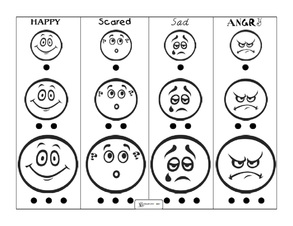
Golden Path Games:
Art - J Siracusa; Board design - A Romero
When young children act out in response to upsetting events, they are often directed to “use their words” to express their emotions. To follow this directive, the child needs to be able to internally process their emotional reactions and then translate that understanding into words. This is beyond the ability of many young children.
In this activity, a chart is used to help the young child better identify his or her own inner emotional state and then convey that information to others. This activity also helps young children recognize that the intensity of one’s emotional reaction to an event may vary, depending on other variables, and that one can take action to regulate the intensity of one’s emotions.
Click here to view and print the Mixed Emotions Junior chart.
Click here to view and print the Show Me How You Feel! instructions.
"Speak from the Heart" Word Finder
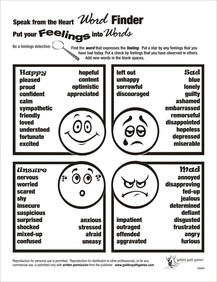
Summer 2012: Family Feelings Check-In
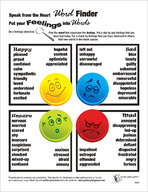
Summer 2012 Featured Technique: Family Feelings Check-In
Click here to print instructions
Click here to print Feelings Word Finder (pictured at left)
Click here to print a black and white version of the Word Finder
.
Red-Light-Green Light

That's A Good Question: Family Edition
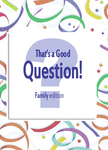
This game is fun and a great therapeutic tool. Helps families talk about topics that are close to the heart!
Click on the image at left view and print That's a Good Question.
Click on the image at left view and print That's a Good Question.
Template to make your own cards for
the Mixed Emotions game
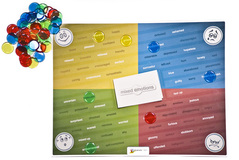
If you have purchased Mixed Emotions, you can add cards to the game by creating your own. Click on a link below to view and print template:
Option 1: template with lines
Option 2: template without lines
For best results when you print, select Scaling: None on your printer's dialog box